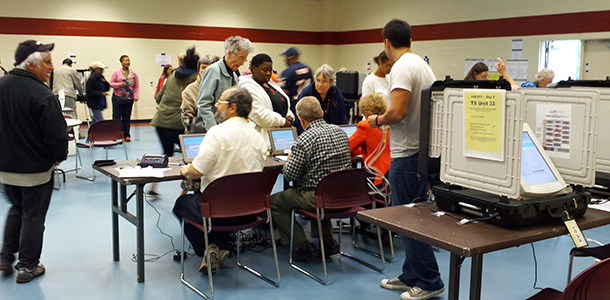
(Photo Credit: Ben Schumin/Wikimedia)
It’s the heart of budget season in the California Legislature, and there are many hands grabbing for a piece of the proverbial pie. With so many worthy recipients, the budgeting process can be a difficult, complex and contentious one.
Often during this process, the most long-standing and essential function of our democracy gets the short end of the stick, and that’s elections. And with a particularly heated presidential election in the midst, this may be the perfect opportunity to snag a piece.
California’s counties are in charge of administrating elections, yet they have not received a piece of that budget pie in almost six years and are eager to see some of the nearly $120-million dollar backlog for state-mandated election programs, like providing absentee ballots.
On Thursday, the Senate Elections and Constitutional Amendments Committee and Budget Subcommittee hosted a joint hearing to entertain this very topic.
Secretary of State Alex Padilla and representatives from the Legislative Analyst’s Office, the California Association of Clerks and Election Officials and other organizations testified that, if funding isn’t increased for elections in California, we could find ourselves in a potentially sticky situation.
Exceptionally high voter turnout is expected with California’s almost unprecedented relevance in the presidential primary, a record number of initiatives are expected to drain already cash-strapped counties and significant resources are needed to educate voters on voting, registration status and party affiliation.
Padilla, who warned on Thursday that California might need to print a 200-page voter guide later this year, has requested an extra $32 million to cover costs of the expected June primary voter surge.
Given the fear of an incident similar to Florida in 2000 or this year’s Arizona primary, chances are better that the state will help counties and pitch in some extra cash to avoid a disaster.
But funding will remain a long-term challenge.
Solano County Supervisor Erin Hannigan agrees and wasn’t afraid to say it on Thursday.
Hannigan testified that one-time funding will help ensure successful outcomes during this election season, but also warned of the pressures counties face that will require long-term solutions.
“First, county voting systems are aging rapidly” said Hannigan. “The state is looking at ways to bring California’s elections into the 21st century…this will be the basis for the next decade of elections in our state.”
According to California Forward’s election funding research, around 76 percent of participating counties reported needing to replace voting equipment within 3 to 4 years. With no state funding to do so, many are unsure of how to pay for the next generation of voting systems.
The Supervisor also warned the committee of the unpredictable expenses associated with special elections. These elections are impossible for officials and county supervisors to plan for and are very costly. Additionally, the state has not helped fund a special election since 2009.
“Counties are no longer reimbursed for running special elections to fill legislative or congressional vacancies, which will be triggered like dominoes following the November election as current office holders win new seats,” said Hannigan. “These single contest elections can cost counties millions to run with no good way to set aside resources accordingly for the ‘what if’ scenario should primaries fail to produce a winner and a general special election must be held.”
This issue could potentially be addressed by legislation by Assemblymember Jim Patterson, who has introduced a bill, which would require elected officials who vacate office early to pay for special elections out of their campaign funds. Even if AB 2284 became law, there is much more to be done to ensure the cost of elections is shared equitably.
Lastly, Hannigan discussed the ever-looming backlog of funding that is owed by the state to cover state-required election programs.
“These mandates are proposed for suspension again this year, and despite their integral role in voting systems, we have no indication for repayment at this time” said Hannigan. “All of this is happening when the cost of administering elections is growing. Despite lower voter turnout, it has grown by as much as 270 percent over the last 20 years.”
Thanks to calls to action by Secretary Padilla and county officials, as well dedicated research by the Legislative Analyst’s Office and Department of Finance, a solid case is being made for a serious look at funding this year’s elections. However, the undertone in much of the testimony was clear — there are long-term funding issues that remain unresolved.
These are the issues California Forward addresses in its Election Funding Project report to be released in the coming weeks. The report outlines research conducted on how elections are funded both nationwide and throughout California, and provides recommendations to fund the future of California’s elections.
“CA Fwd was created to be the link between good ideas, sound analysis and visionary recommendations and the actual enactment and implementation needed to grow jobs, promote cost-effective public services and create accountability for results,” said Jim Mayer, CA Fwd president and CEO. “Addressing this long-standing issue is important to help improve voter participation in California.”
This year, with surging interest in this election cycle, it is even more apparent that well-funded elections are the cornerstone to ensuring the integrity of our democracy.
UPDATE: The special elections funding bill, AB 2284, failed to pass in the Assembly Elections and Redistricting Committee.

